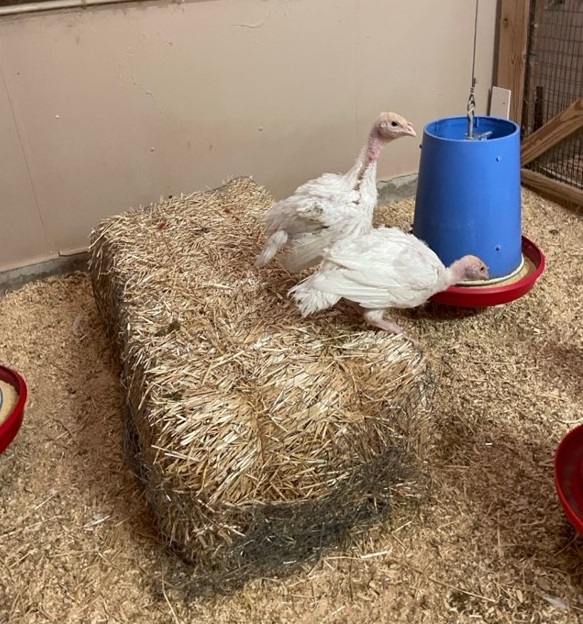By Nathan Griffith, BS
Graduate student, Animal Welfare/Behavior
Purdue University
Providing an enriching experience to turkeys can have many benefits. However, finding the right tool to work in an environment and meet the needs of everyone involved is the tricky part.
There are many ways we can work with poultry, but ensuring they are kept safe and are given adequate care is a top priority. Although animal welfare has been a hot-button issue in recent news, it is a topic that already has an extensive body of knowledge and literature that is growing every day.
Animal welfare
Animal welfare is defined as “an animal’s ability to cope with its environment.”1 Animal-welfare research has become an area of increased interest for consumers and has led to many changes in the industry.
Stakeholders are dedicated to ensuring that animals can thrive in production environments. The animal’s environment is key to this, so we must ensure that we are providing production animals with the optimal chance to be successful.
Environmental enrichment
Environmental enrichment (EE) provides animals of any species a way to explore their environment and mitigate the chances of developing unwanted or injurious behaviors, such as aggressive pecking and feather pecking among turkeys, that can be harmful.
Incorporating EE into turkeys’ environments is one of the ways that researchers are mitigating these behaviors. Depending on the environment being used and the intended end use of the animals, applying EE can have numerous benefits, including reduced reactivity and enhanced brain functioning.2
For my project at Purdue University, I am investigating ways we can mitigate turkey leg-health issues by providing various EE. We have tested six EE applications, observing that EE improved footpad health and positively influenced the bodyweight of male turkey toms.
EE can look very different depending on the setting, but all EE should work easily in the animals’ environment. There are 5 major types of enrichment:3
- Nutritional EE is edible, such as pecking blocks.
- Sensory EE allows the animal to experience diverse kinds of auditory, visual, olfactory and novel stimuli. One example of this is providing music.
- Occupational EE is the provision of objects for manipulation and play. A straw bale is a great example of this, as the animals can climb on it and deconstruct it to add to their litter.
- Physical EE changes the animals’ space, either in quantity or quality. This can be as easy as changing the type of litter or flooring provided to the animals, or using a combination of both and conducting preference tests to determine which is preferred.4
- Social EE is among conspecifics or incorporation of human interaction. This can look like caretakers spending more time with the animals but refraining from handling the animals, or providing the animals with an appropriate social environment that enables them to interact with conspecifics.
Providing turkeys with EE could also allow them to express play behavior, depending on their age. Play behavior is spontaneous and non-injurious, and occurs in times that do not have an immediate survival or reproductive function. There is currently no optimal level of play, but the absence of play in young birds may suggest that there is a welfare deficit.5
Play behavior can be hard to recognize but is a valuable indicator of a positive affective state.6 This positive affective state contributes to quality of life and may have an important role in mitigating stress.7
What’s next?
Various companies opt in to third-party accreditation programs, such as those of American Humane, Animal Welfare Approved and Global Animal Partnership. These organizations have standards for providing EE.
The science of optimal EE for turkeys is still evolving. Newly developed and current EE provide turkeys with additional positive experiences. Although research is ongoing, the potential benefits of implementing these tools into the environments of production animals have endless possibilities.
References
- Broom DM. Indicators of poor welfare. Brit Vet J. 1986;142(6):524-526. https://doi.org/10.1016/0007-1935(86)90109-0
- Ball NJ, Mercado E, Orduña I. Enriched Environments as a Potential Treatment for Developmental Disorders: A Critical Assessment. Front Psychol. 2019;10:466. https://doi.org/10.3389/fpsyg.2019.00466
- Orihuela A, Mota-Rojas D, Velarde A, Strappini-Asteggiano A, Vega LTDL, Borderas-Tordesillas F, Alonso-Spilsbury M. Environmental enrichment to improve behaviour in farm animals. CABI Rev. 2019;1-25. https://doi.org/10.1079/PAVSNNR201813059
- Dávila SG, Campo J L, Gil MG, Prieto MT, Torres O. Effects of auditory and physical enrichment on 3 measurements of fear and stress (tonic immobility duration, heterophil to lymphocyte ratio, and fluctuating asymmetry) in several breeds of layer chicks. Poult Sci. 2011;90(11):2459-2466. https://doi.org/10.3382/ps.2011-01595
- Jacobs L, Blatchford RA, De Jong IC, Erasmus MA, Levengood M, Newberry RC, Regmi P, Riber AB, Weimer SL. Enhancing their quality of life: Environmental enrichment for poultry. Poult Sci. 2023;102(1): 102233. https://doi.org/10.1016/j.psj.2022.102233
- Ibid.
- Kaplan G. Play behaviour, not tool using, relates to brain mass in a sample of birds. Sci Rep. 2020;10(1):20437. https://doi.org/10.1038/s41598-020-76572-7








